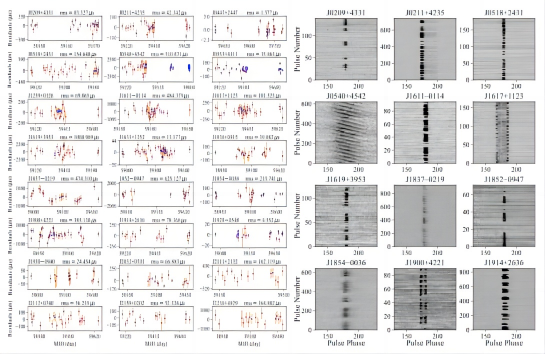Using the Five-hundred-meter Aperture Spherical radio Telescope (FAST), the researchers from Xinjiang Astronomical Observatory (XAO) of the Chinese Academy of Sciences (CAS) obtained the properties of new discovered 2 millisecond pulsars and 22 normal pulsars.
The study was completed by PhD candidate Wu Qingdong, together with his collaborators from the pulsar groups at the XAO and the National Astronomical Observatories of CAS, and the results were published in MNRAS.
Pulsars are rapidly rotating neutron stars. Pulsar timing can accurately measure the rotational parameters, astrometric parameters, and orbital parameters, including period, period derivatives, their position, and proper motion. Besides, astronomer derive the surface magnetic field, characteristic age, and energy loss rate of the pulsar from the rotational parameters.
Moreover, pulsars are used to place limits on the equation of state for ultradense matter, to map the free electron distribution of our Galaxy, to test theories of gravity in the strong-field regime, and be used as tools to detect low-frequency gravitational waves.
The researchers reported these 24 pulsars with phase-connected timing ephemeris, polarization pulse profiles and Faraday rotation measurements. Compared with pulsar population, these pulsars are more dim and distant. Among these sources, J0211+4235 and J0518+2431 are beyond the "traditional death line", ten pulsars show nulling phenomena, and J0540+4542 shows subpulse drifting, which could constraint emission theories.
Furthermore, five ones have dispersion measures higher than the values predicted by the Galactic electron density models, which suggests that models need updating for higher Galactic latitude regions.
“Discovering more pulsars and revealing their nature will help us understand the Neutron star physics and the population properties.” said WU Qingdong.

Left: timing residuals for 24 pulsars as a function of MJD. Right: phase-time plots exhibit nulling phenomena or subpulse drifting or modulation for twelve pulsars.
Contact: WU Qingdong
Xinjiang Astronomical Observatory, Chinese Academy of Sciences
wuqingdong@xao.ac.cn
Article link: https://doi.org/10.1093/mnras/stad1323